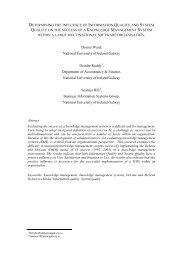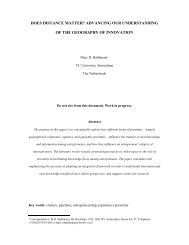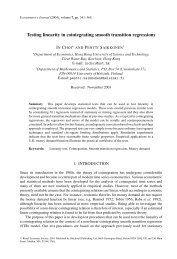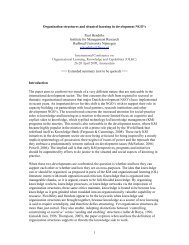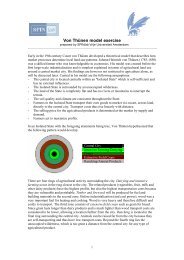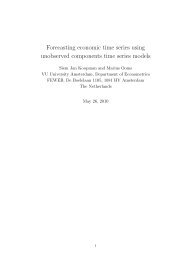The effects of road pricing - Feweb - Vrije Universiteit Amsterdam
The effects of road pricing - Feweb - Vrije Universiteit Amsterdam
The effects of road pricing - Feweb - Vrije Universiteit Amsterdam
You also want an ePaper? Increase the reach of your titles
YUMPU automatically turns print PDFs into web optimized ePapers that Google loves.
elevant dimensions <strong>of</strong> behaviour. Besides a fundamental understanding <strong>of</strong> the possible<br />
<strong>effects</strong> that <strong>road</strong> <strong>pricing</strong> might have, we may also identify possible (in)consistencies (between<br />
disciplines) and open issues.<br />
<strong>The</strong> link between car costs and behaviour is central in this paper. We will focus on <strong>pricing</strong> in<br />
car transport and provide first an overview <strong>of</strong> possible measures and the ways people may<br />
respond to these price changes. Section 3.3 provides an overview <strong>of</strong> modelling results for<br />
various behavioural dimensions. Section 3.4 proceeds with an overview <strong>of</strong> empirical findings.<br />
Elasticities and practical experiences provide valuable knowledge about the <strong>effects</strong> <strong>of</strong> <strong>road</strong><br />
prices and price sensitivity. <strong>The</strong>se two sections have a strong economic perspective. Section<br />
3.5 continues with a brief overview <strong>of</strong> interesting psychological research and compares the<br />
findings <strong>of</strong> both approaches. Finally, Section 3.6 concludes.<br />
3.2 <strong>The</strong> price <strong>of</strong> car use and behavioural response<br />
Governments are very much involved in the transport market. Hence, transport prices are<br />
<strong>of</strong>ten set or influenced by the public sector. Governments may have several reasons or<br />
objectives for changing prices. Pricing measures are <strong>of</strong>ten used to raise revenues, they assist<br />
in traffic control and contribute towards the internalisation <strong>of</strong> external costs. Most <strong>of</strong>ten it is a<br />
combination <strong>of</strong> these objectives that is behind the implementation <strong>of</strong> a <strong>pricing</strong> scheme.<br />
Transport <strong>pricing</strong> measures can be very diverse and very much targeted towards a certain type<br />
<strong>of</strong> behaviour. B<strong>road</strong>ly speaking, transport <strong>pricing</strong> measures can be divided into five different<br />
types, according to the way charges and payments are applied (CAPRI, 1998):<br />
• Vehicle <strong>pricing</strong>, related to car ownership and usage (independent <strong>of</strong> the <strong>road</strong>s used);<br />
• Road <strong>pricing</strong>, related to use <strong>of</strong> specific <strong>road</strong>s and areas (possibly at specific times);<br />
• Parking <strong>pricing</strong>, related to use <strong>of</strong> parking spaces;<br />
• Public transport <strong>pricing</strong>, related to use <strong>of</strong> public transport;<br />
• Special taxes or subsidies, for instance related to commuting (e.g. tax allowance to deduct<br />
commuting costs when using public transport), real estate, or particular locations (e.g.<br />
near public transport facilities).<br />
This <strong>of</strong>fers governments a wide range <strong>of</strong> direct and indirect price instruments that can be<br />
implemented as part <strong>of</strong> a policy to ensure correct charging for transport. Transport system<br />
users currently do not perceive the full marginal social costs <strong>of</strong> their travel decisions. This<br />
leads to traffic volumes in excess <strong>of</strong> what is socially desirable, and it implies a suboptimal<br />
distribution <strong>of</strong> transport flows over time and space. For dealing with the various types <strong>of</strong><br />
externalities (congestion, noise, and so on) economic theory argues that prices should be set<br />
according to marginal social costs. For various (practical) reasons, this first-best type <strong>of</strong><br />
<strong>pricing</strong> is generally not used or even feasible in transport (see also Chapter 2). However, there<br />
are several policy instruments available to governments which can be used to deal with the<br />
various externalities. Current widely implemented price measures in <strong>road</strong> transport include a<br />
tax on vehicle ownership (either at purchase or on an annual basis), parking fees, and fuel<br />
taxes. Alternative <strong>pricing</strong> measures include distance-related taxes (e.g. a kilometre charge) or<br />
particular emission-based charges. <strong>The</strong> opposite <strong>of</strong> charging, viz. subsidising, is also a price<br />
instrument. Public transport subsidies are, for instance, <strong>of</strong>ten seen as a useful second-best<br />
policy in cases where private <strong>road</strong> transport for some reason cannot be, or is not priced.<br />
Transport users will respond differently to various <strong>pricing</strong> policies; some people change<br />
behaviour, others don’t. When people decide to change, possible outcomes (in terms <strong>of</strong><br />
behavioural responses) <strong>of</strong> <strong>pricing</strong> can be the following:<br />
• trip suppression (travel frequency choice);<br />
• departure time choice (and scheduling <strong>of</strong> daily activities);<br />
• different route choice;<br />
34





